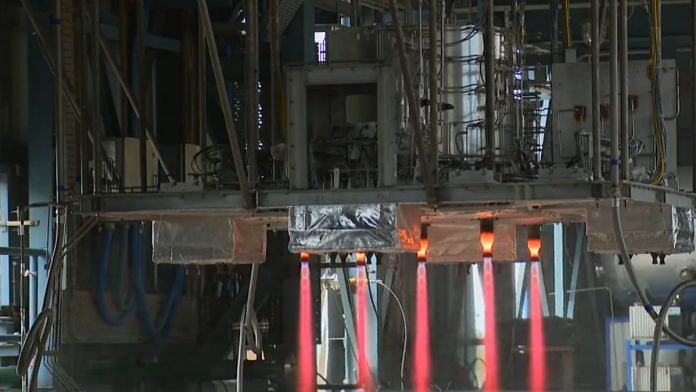New Delhi: Two ‘hot tests’ for the Gaganyaan’s propulsion system conducted by the Indian Space Research Organization (ISRO) were successful, the space agency announced in a 9 July press release. The tests were conducted on 3 July at the ISRO Propulsion Complex (IPRC) in Mahendragiri, Tamil Nadu.
The Gaganyaan Service Module is one of two modules on India’s inaugural human spaceflight mission. It will carry the fuel, engines, power systems, and other important components for the spacecraft. It will be attached to the crew module, which is where the three astronauts on the mission will live and work.
Hot tests are live demonstrations of the rocket engines using real fuel in a system, rather than just simulations. It is a critical step in preparing the modules for the real flight. On 3 July, the propulsion system, i.e., the jet engines and thrusters, was fired up and tested to check for any problems. According to the press statement, there were two tests (one for 30 seconds and the other for 100 seconds), both of which showed positive results.
The propulsion system for the service module of Gaganyaan consists of 5 liquid apogee motors (LAM), which are large engines, and 16 reaction control system (RCS) thrusters, which are smaller thrusters used for propelling. Tests conducted on 3 July ensured both these systems worked separately as well as together, the way they would in a real flight mission.
“During the 100s test, simultaneous operation of all RCS thrusters in different modes (steady state; pulsed) along with all LAM engines was also successfully demonstrated,” read the press statement.
The service module propulsion system will be used on the Gaganyaan for orbital maneuvers, which means moving or adjusting the spacecraft’s position in orbit. It will also be necessary to propel emergency abort scenarios, if needed.
The success of these short-duration tests has given ISRO the confidence to conduct a full-duration hot test of the propulsion system soon, said the statement.
According to a May 2025 press conference by Jitendra Singh, Union Minister of State (Independent Charge) for Science and Technology, the Gaganyaan Mission is in its “final stages” and scheduled for a 2027 launch.
Earlier this year, ISRO had announced that it had integrated the Crew Module with a propulsion system too.
Also Read: Who is Anil Menon, Indian-origin NASA astronaut set to embark on his 1st mission to ISS in 2026
Gaganyaan modules
The overall orbital module of Gaganyaan consists of the crew and service modules working in tandem. As described above, the service module’s propulsion system is responsible for placing the spacecraft in the correct orbit and for maneuvering during emergencies.
The crew module, on the other hand, is responsible for the orientation of the spacecraft, and re-entry and descent while returning to the ground.
The service module propulsion system that was tested last Thursday was developed by ISRO’s Liquid Propulsion System Centre (LPSC), one of the leading ISRO centres with offices in both Bengaluru and Thiruvananthapuram. ISRO Chairman V. Narayanan was formerly the director of the LPSC before taking charge as chairman.
The Gaganyaan mission is India’s first human spaceflight mission. It will launch a three-member crew to the Low-Earth-Orbit (LEO) at a distance of nearly 400 km from the ground for a three-day mission and then bring them back safely. Before the 2027 crewed mission however, there will be a mission by the end of 2025 where the robot Vyommitra will take a flight to space. This is to test all possible contingencies and safety checks on the Gaganyaan Mission before the crewed mission is expected to launch.
Currently, one of the astronaut-designates for the Gaganyaan Mission—IAF Group Captain Shubhanshu Shukla—is in the International Space Station (ISS) aboard the Axiom-4 Mission.
(Edited by Amrtansh Arora)
Also Read: HAL to become first PSU to build rockets for ISRO






